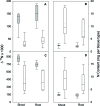Organic or Inorganic Nitrogen and Rhizobia Inoculation Provide Synergistic Growth Response of a Leguminous Forb and Tree
- PMID: 31695714
- PMCID: PMC6817612
- DOI: 10.3389/fpls.2019.01308
Organic or Inorganic Nitrogen and Rhizobia Inoculation Provide Synergistic Growth Response of a Leguminous Forb and Tree
Abstract
Our objective was to better understand how organic and inorganic nitrogen (N) forms supplied to a tree, Robinia pseudoacacia, and a perennial forb, Lupinus latifolius, affected plant growth and performance of their symbiotic, N-fixing rhizobia. In one experiment, we tested five sources of N [none; three inorganic forms (ammonium, nitrate, ammonium-nitrate); and an organic form (arginine)] in combination with or without rhizobia inoculation. We measured seedling morphology, allometry, nodule biomass, and N status. A second experiment explored combinations of supplied 15N and inoculation to examine if inorganic or organic N was deleterious to nodule N-fixation. Plant growth was similar among N forms. A positive response of nodule biomass to N was greater in Robinia than Lupinus. For Robinia, inorganic ammonium promoted more nodule biomass than organic arginine. N-fixation was concurrent with robust supply of either inorganic or organic N, and N supply and inoculation significantly interacted to enhance growth of Robinia. For Lupinus, the main effects of inoculation and N supply increased growth but no interaction was observed. Our results indicate that these important restoration species for forest ecosystems respond well to organic or inorganic N forms (or various forms of inorganic N), suggest that the nodulation response may depend on plant species, and show that, in terms of plant growth, N supply and nodulation can be synergistic.
Keywords: Lupinus latifolius; Robinia pseudoacacia; amino acid; arginine; inorganic nitrogen; isotopic nitrogen; nitrogen fixation; organic nitrogen.
At least a portion of this work is authored by R. Kasten Dumroese and Jeremiah R. Pinto on behalf of the U.S. Government and, as regards Dr. Dumroese, Dr. Pinto, and the U.S. Government, is not subject to copyright protection in the United States. Foreign and other copyrights may apply.
Figures



References
-
- Adgo E., Schulze J. (2002). Nitrogen fixation and assimilation efficiency in Ethiopian and German pea varieties. Plant Soil 239, 291–299. 10.1023/A:1015048331366 - DOI
-
- Antos J. A., Halpern C. B. (1997). Root system differences among species: implications for early successional changes in forest of western Oregon. Am. Midl. Nat. 138, 97–108. 10.2307/2426658 - DOI
-
- Bado B. V., Bationo A., Cescas M. P. (2006). Assessment of cowpea and groundnut contributions to soil fertility and succeeding sorghum yields in the Guinean savannah zone of Burkina Faso (West Africa). Biol. Fertil. Soils 43, 171–176. 10.1007/s00374-006-0076-7 - DOI
-
- Bigg W. L., Daniel T. W. (1978). Effects of nitrate, ammonium and pH on the growth of conifer seedlings and their production of nitrate reductase. Plant Soil 50, 371–385. 10.1007/BF02107186 - DOI
-
- Bollman M. I., Vessey J. K. (2006). Differential effects of nitrate and ammonium supply on nodule initiation, development, and distribution on roots of pea (Pisum sativum). Can. J. Bot. 84, 893–903. 10.1139/b06-027 - DOI
LinkOut - more resources
Full Text Sources
Other Literature Sources

